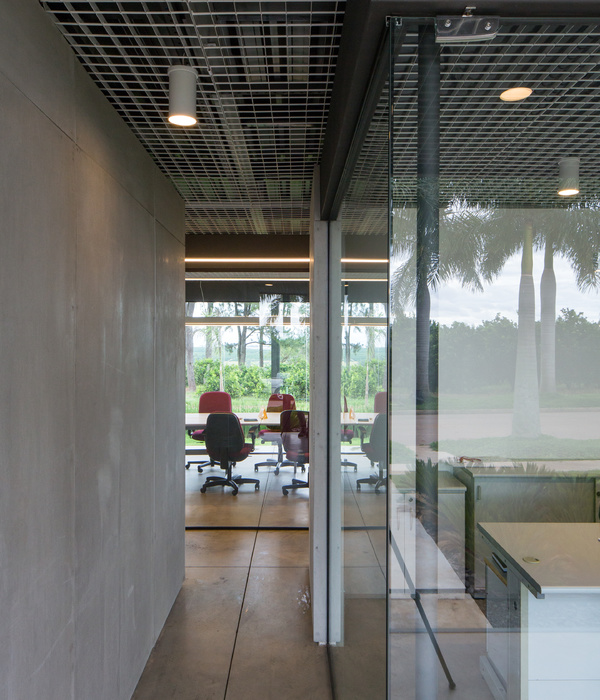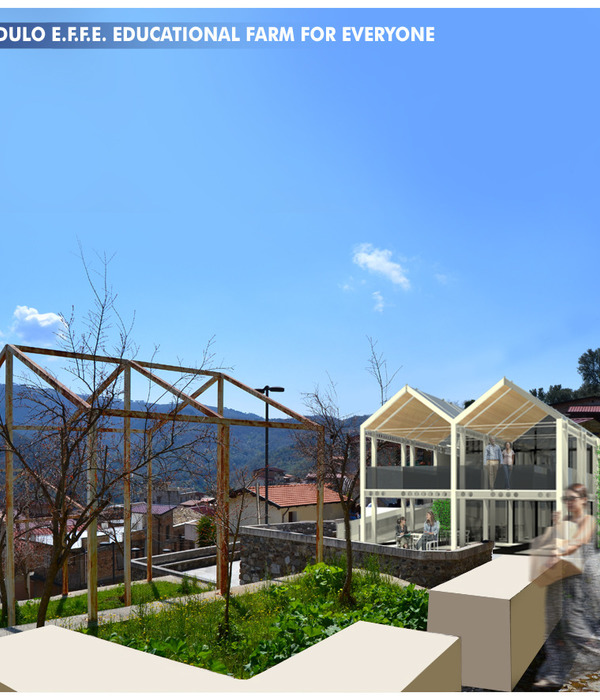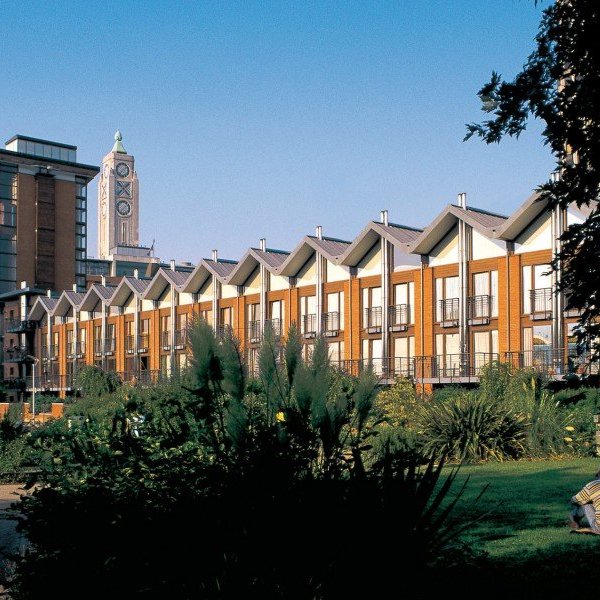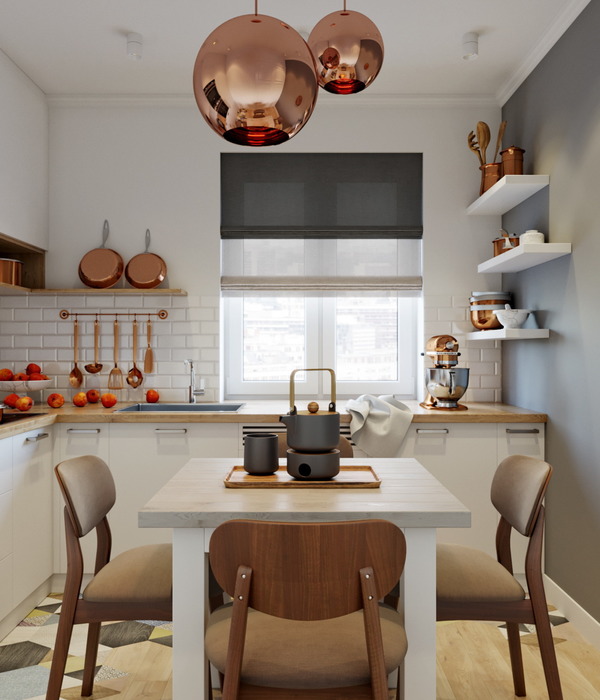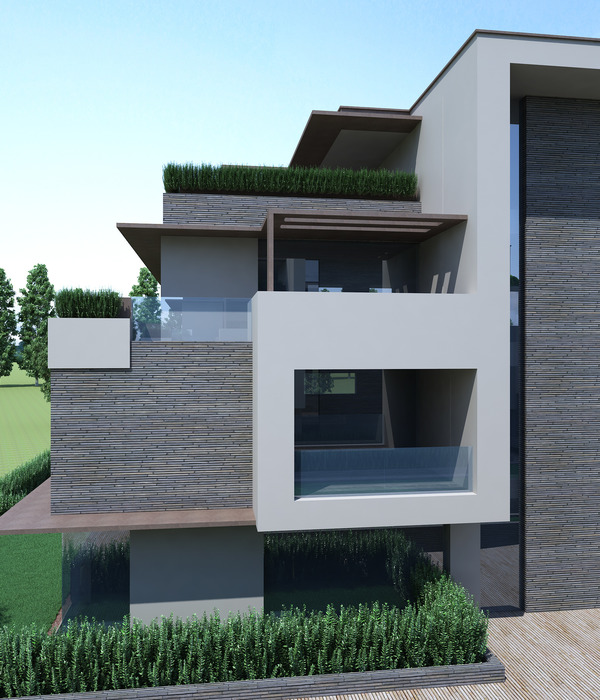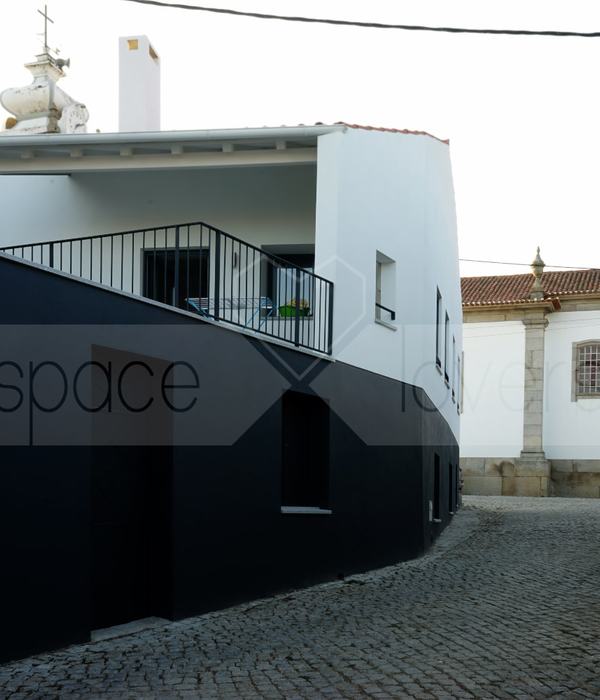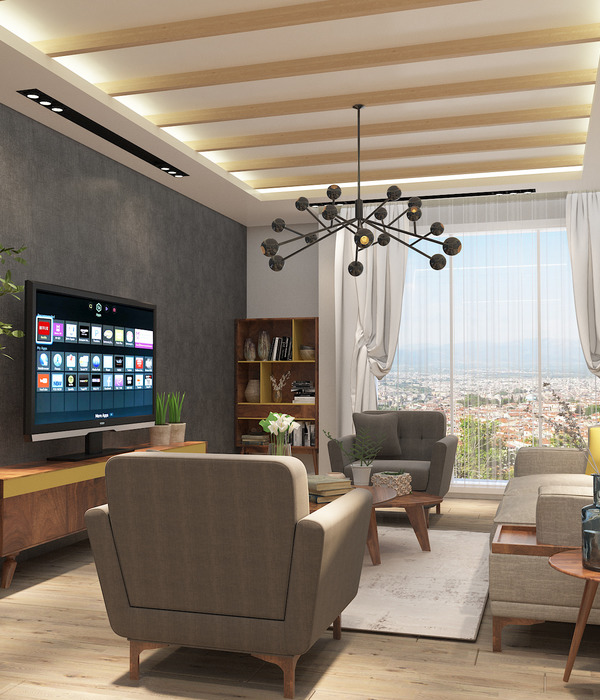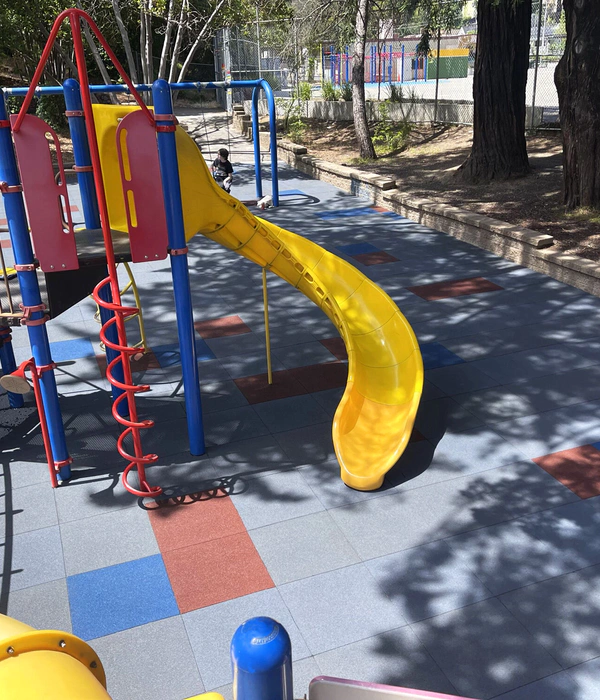- 项目名称:8342长三角路演中心
- 项目地点:亭枫公路8342号
- 设计单位:AND Studio安棣建筑事务所
- 业主:上海建工金山建设发展有限公司
- 造价:1.8亿
- 建成状态:建成
- 设计时间:2017年07月—2018年06月
- 建设时间:2017年10月—2018年11月
- 用地面积:123亩(82000平方米)
- 建筑面积:15303.39平方米
- 材料:上海建工集团二建,上海市建筑装饰工程集团有限公司
- 摄影师:mlee(摄影+影像),view建筑摄影(摄影)
枫泾古镇位于上海市金山区,沪浙交界处,古镇具有典型江南水乡的特点,区内河道纵横。项目基地位于原上海市第七印绸厂金山分厂,其所在位置曾是元代的驿站、明清的砖窑,场地北侧还有抗战时期抵抗倭寇的碉堡,厂房园区废弃多年,占地面积约 123 亩,建筑面积约 15,400㎡。我们在接到业主的委托后,对园区内规划、建筑、景观进行了系统性循序渐进的改造与升级。8342 长三角路演中心也将成为整个枫泾古镇开发的启动区。
项目鸟瞰,aerial view of the project©Mlee
城市更新最大的挑战,是在有限投入的限制下重新赋予老建筑最适宜的新功能。在整个工作过程中,我们梳理了四个基本目标对老印绸厂进行改造升级。
1. 城市更新不是对建筑进行简单的翻新,而是对建筑的整体身份和整体功能的一个反复论证,找到最合适于它的新身份——更有利于未来的、功能上的更新。在所有的限制条件里,有限的投入内,根据不同的空间特质,通过建筑师对复杂功能及业态综合处理的经验,最大化地找到每个建筑未来的使用功能,并在使用和运营上为甲方找到一个合适的解决方案。
2. 整体性的空间形象塑造,在复杂与混乱的冲突中,通过建筑、景观等手法重新定义园区的身份。在无序的现状中,既通过整体景观概念梳理出一条主线及脉络,又能够通过赋予园区一个新的爆点、一个鲜明的形象,将个体重新回归到整体中去。
3. 将工业建筑与江南古镇相融合,运用当地材料和现有材料的转换,体现在地性。我们使用了“砖”这种古老材料去试图探寻场所的根基,传承并保持它的历史特征,同时又通过白墙的白色,江南屋顶的灰色,使工业园区重新回归到古镇中去。
4. 以生态景观、绿色建筑的手法对工业生产给场所造成的破坏、污染进行“修补”。对水体污染的修复,也令园区重拾其江南水乡的风貌。建成后,8342 长三角路演中心园区获得了美国可持续绿色社区 LEED-ND 金级认证。
▼改造后顶视图,top view of the project after renovation©Mlee
The greatest challenge of urban renewal project is to re-endow the old building with the most appropriate new functions within the constraints of limited investment. In the whole transformation process, we sorted out four basic goals to transform and upgrade the old silk printing factory.
1. Urban renewal is not a simple renovation of a building, but a repeated demonstration of the overall identity and function of the building, and finding the new identity that is most suitable for it. The transformation should be a futuristic functional upgrade. The architect, based on his comprehensive experience of dealing with complex functions, needs to maximize the future use of each building and find a suitable solution for the client in terms of operation, within all the constraints.
2. Integral space image shaping, which is to redefine the identity of the park through architecture, landscape and other methods in the conflict between complexity and chaos. In the disordered status, a main line and thread should be sorted out through the concept of the overall landscape, and individuals should also be returned to the whole by giving the park a new iconic point and a distinct image.
3. To integrate industrial buildings with historical Jiangnan water towns, and to reflect to the local identity, we choose to use and converse existing materials. We use the historical material ‘brick’ to try to explore the foundation of the site, inherit and maintain its historical characteristics. At the same time, through the white of the white walls and the gray of the roof in Jiangnan style, the industrial park is integrated with the historical town.
4. The damage and pollution caused by industrial production was ‘repaired’ by means of ecological landscape and green architecture. The restoration of water pollution also makes the park recapture its style as a Jiangnan water town. After its completion, 8342 Yangtze River Delta Road Show Center Park was awarded with LEED-ND Gold certification.改造后项目鸟瞰,aerial view of the project after renovation©Mlee
▼8、9、10 号楼北侧,north elevation of building #8, #9 and #10©Mlee
位于园区北侧的原 8 号楼厂房以全新的钢结构屋顶进行更替,在造型上尊重原建筑尺度,我们将西半边厂房的屋顶拆除后,新的屋顶旋转了 90 度设置,被重新分割的东西两侧之间增设了玻璃连廊,室内与室外的界限被打破了。通过这一系列改动消除原始厂房布局过于狭长以及单一的方向感,同时得益于新增的钢结构屋架,日间充沛的屋顶天窗采光得以实现;于建筑东侧中心开辟新的室外庭院,四面环绕的玻璃幕墙将室外光线进一步引入室内,结合照度感应耦合技术以及太阳能光伏系统(电量为建筑提供全年能耗的 20%),大大减少了建筑对能耗的需求。
▼8 号楼轴测结构分解图,exploded axonometric of building #8©And STUDIO
▼8 号楼外观,external view of the building #8©Mlee
▼8 号楼夜景,night view of building #8©Mlee
▼8、9 号楼及连廊,building #8 and #9 connected by a corridor©Mlee
8 号楼庭院,courtyard in building #8©Mlee
▼8 号楼室内,不同材料的对比,interior of building #8, contrast between different materials©Mlee
厂房建筑闲置多年,且年代久远,缺乏真实准确的图纸。残垣断壁之上除去主要结构外,饰面材料以及临建部分已经破旧不堪,无法再次利用。在确立完更新概念方案后,首要的任务是对原建筑结构及场地进行准确的测绘以及荷载范围的判定。在复核的过程中,发现位于厂区中心的 11 号楼南北两侧的建筑结构在中央部分产生了错位,在后续设计中,我们恰巧利用了原本错位的结构,并在如何利用新结构去补强、增建的过程中诞生了崭新的设计思路。以交错的拱形钢结构在错位的混凝土柱上设计了高穹顶,巧妙地连接了两座结构一致却错开的厂房。同时在厂房中间设置了一座双向舞台,贯穿室内外,也将室外绿地景观引入了室内。
11 号楼外观,external view of building #11©view 建筑摄影
双向舞台,two-way stage©Mlee
地处园区中心的 11 号楼,被赋予新的多功能布局之后,在流线上缺少明确的主入口,通过将两跨室内墙体拆除,设计并置入了新的金色形体,创造出沿园区主路更为醒目的入口形象。在原混凝土结构内部施工安装、对保留植被进行退让、多专业之间相互协调,都充分体现了城市更新、改建类项目上的难点与挑战。
Building #11, which is located in the center of the park, has been given a new multi-functional layout, but it lacks a clear main entrance on the circulation. By removing two spans of interior walls, a new golden shape was designed and placed to create a more striking entrance along the main road of the park. Solving the problems, including the construction and installation of the original concrete structure, the concession of the reserved vegetation, and the coordination among various specialties, fully reflect the difficulties and challenges in urban renewal and reconstruction projects.
▼11 号楼入口,entrance of building #11©view 建筑摄影
▼醒目的金色形体,golden volume catching people’s eyes©view 建筑摄影
▼交错的拱形钢结构连接错位的厂房,staggered arched steel structure connecting dislocated volumes©view 建筑摄影
保留混凝土内部结构,concrete structure inside the building is remained©Mlee
园区在城市更新过程中,以坚持历史呈现感和可识别性为原则。将至今保存较好的抗日碉堡设计成景观公园的一部分,保留并修缮了标志性的烟囱、水塔,通过结构加固及灯光美化,焕发新生。改建后的园区景观遵照海绵社区的概念,以高达 61% 的绿化率,可呼吸的硬质铺地,对雨水进行收集与再利用。10 号楼在设计过程中改变了它原本背朝水面的布局,调换了主立面的方向,新的主立面朝着水体一字铺开。我们还设计了一个水上舞台,为今后的运营与功能提供了更为广泛的扩展性。也因为这个新的布局,对氮磷严重超标的污染水体进行了生态修复。通过土壤修复技术、水生植物群落构建技术、水系森林构建技术,使湖水恢复自净功能,改善了整个园区的生态环境。
▼10 号楼外观,external view of building #10©Mlee
2 号楼、3 号楼、4 号楼、5 号楼,在布局上通过新建的室外景观长廊把原本散落的建筑重新连接起来。以基地内古砖窑遗址及原始建筑肌理为灵感来源,用几种不同的砖墙砌面更新了厂房外立面,底层被尽可能扩大的玻璃幕墙与红砖立面凸显了其虚实关系。
Building #2, #3, #4, and #5 are scattered buildings, reconnect through the newly built outdoor landscape corridor. Taking the historical brick kiln ruins and the original building texture as inspiration sources, several different brick wall claddings were used to update the exterior facade of the factory building. The glass curtain wall and red brick façade on the ground floor are expanded as much as possible to highlight the relation between blankness and actuality.
▼2、3、4、5 号楼鸟瞰,aerial view of building #2, #3, #4 and #5©Mlee
▼2 号楼外观,external view of building #2©Mlee
▼3 号楼外观,external view of building #3©Mlee
在逐一推进的过程中,我们也得到了业主更多的信任,并因此提升了后期配合,现场决策的效率,并在材料的选择与订制,从规划、景观、单体建筑、室内功能甚至到运营上的构想上,建筑师都能更大程度地对项目进行全方位的把控。
In the process of the transformation of the park, we also won more trust from the client, and thus improved the efficiency of coordination and on-site decision-making. The architect has a greater degree of control over the selection and customization of materials, site planning, landscape design, individual architectural transformation, interior functions, and even the ideas of the park operations.
▼不同材料的对比,contrast between different materials©view 建筑摄影
▼8 号楼室内,楼梯与接待台,interior of building #8, reception and staircase©Mlee
▼11 号楼室内,吧台,interior of building #11, bar area©Mlee
在这个从单体到复数的设计过程中,针对每个空间的属性找到可转化的功能,在项目建成后一年多的使用期里,除了常规的展览、会议、路演等活动外,这里还举办了体育赛事、服装及产品发布会,承接了影视剧拍摄。今天园区的一部分又将被改造成艺术空间,这也充分展现了其设计的灵活性与可塑性。
In the design process from monomer to multi-units, we find that functions can be transformed according to the properties of each space. After the completion of this project, in addition to regular activities like exhibitions, conferences, road shows, the site also hosted sports events, clothing and product launches, and undertook film and TV series shooting during the year. Today, another part of the park will be transformed into an art space, which fully demonstrates the flexibility of its design.
▼夜景鸟瞰,aerial view of the project in the night©Mlee
项目名称:8342 长三角路演中心
项目类型:规划,建筑设计,建筑改造,景观设计,室内设计
项目地点:亭枫公路 8342 号
设计单位:AND Studio 安棣建筑事务所
施工图深化设计:上海建工集团工程研究总院
景观设计与深化:上海市园林设计研究总院
室内施工图深化:上海市建筑装饰工程集团有限公司设计院
主创建筑师:王宁
设计团队完整名单:NGO Quyettien、毛建军、杨卫军、陈聪、隋欣、王子牧、周毅、王贝特
业主:上海建工金山建设发展有限公司
造价:1.8 亿
建成状态:建成
设计时间:2017 年 07 月—2018 年 06 月
建设时间:2017 年 10 月—2018 年 11 月
用地面积:123 亩(82000 平方米)建筑面积:15303.39 平方米
规划:AND Studio
建筑:AND Studio
结构:上海建工集团工程研究总院
景观:上海市园林设计研究总院
室内:AND Studio,6# 8# 11#
照明:上海徽之度照明科技有限公司
幕墙:上海市建筑装饰工程集团有限公司
施工:上海建工集团二建,上海市建筑装饰工程集团有限公司
材料:上海建工集团二建,上海市建筑装饰工程集团有限公司
摄影师:mlee(摄影++ 影像),view 建筑摄影(摄影)
Project Name: 8342 Yangtze River Delta Roadshow Center
Type: Planning, Architecture, Renovation, Landscape, Interior
Project Location: N0.8342, Tingfeng Road, Fengjing Town, Jinshan, Shanghai
Design: AND Studio
Design Principal: Ning Wang
Design Team: NGO Quyettien, Mao Jianjun, Yang Weijun, Chen Cong, Wang Zimu, Zhou Yi, Wang Beite
Clients: Shanghai Construction Group Jinshan Development co., Ltd
Cost: 180 millionStatus: Built
Design Stage: 2017.July – 2018.June
Construction Stage: 2017.Oct – 2018.Nov
Site Area: 82,000 m²
Gross Built Area: 15,303.39 m²
Planning: AND Studio
Architecture Design: AND Studio
Structure Consultant: Shanghai Construction Group Design & Research Institute co., Ltd
Landscape Consultant: Shanghai Landscape Architecture Design & Research Institute co., Ltd
Interior Design: AND Studio((Building 6#, 8#,11#)Lighting Consultant: Shanghai Hui Zhi Du Lighting Technology co., Ltd
Façade Consultant: Shanghai Building Decoration Engineering Group co., Ltd
Contractor: Shanghai Construction Group II Construction; Shanghai Building Decoration Engineering Group co., Ltd
Photo Credits: Mlee (video +photography), View Photos
{{item.text_origin}}

